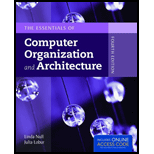
Concept explainers
Explanation of Solution
Types of instructions:
Data movement:
Data movement instructions are used most frequently. With the use of these instructions, data is moved from memory into registers, from registers to registers, and from registers to memory, and many machines also provide different instructions depending on the source and destination. These instructions include MOVE, LOAD, STORE, PUSH, POP, EXCHANGE and various variations on each of these.
Arithmetic operations:
The instructions that use integers and floating-point numbers are categorized as arithmetic operations. Many instruction sets provide different arithmetic instructions for various data sizes. These instructions also provide different instructions for different combinations of register and memory accesses in different addressing modes. These instructions include ADD, SUBTRACT, MULTIPLY, DIVIDE, INCREMENT, DECREMENT, and NEGATE.
Boolean logic instructions:
These instructions perform operations which work similar to that of arithmetic operations. Logic operations are used to control input/output devices. As with arithmetic operations, logic operations affect the flag register. These instructions include AND, NOT, OR, XOR, TEST, and COMPARE.
Bit manipulation instructions:
These instructions are used to set and reset individual bits within a given word...
Want to see the full answer?
Check out a sample textbook solution
Chapter 5 Solutions
The Essentials of Computer Organization and Architecture
- What significant justification is there for the -> operator in C and C++?arrow_forwardMultidimensional arrays can be stored in row major order, as in C++, or in column major order, as in Fortran. Develop the access functions for both of these arrangements for three-dimensional arrays.arrow_forwardWhat are the arguments for and against Java’s implicit heap storage recovery, when compared with the explicit heap storage recovery required in C++? Consider real-time systems.arrow_forward
- 8. Name and Email AddressesWrite a program that keeps names and email addresses in a dictionary as key-value pairs. The program should display a menu that lets the user look up a person’s email address, add a new name and email address, change an existing email address, and delete an existing name and email address. The program should pickle the dictionary and save it to a file when the user exits the program. Each time the program starts, it should retrieve the dictionary from the file and unpickle it. How would the user be able to use the program?arrow_forwardPlease solve and answer the question correctly please. Thank you!!arrow_forwardPlease solve and answer the question correctly please. Thank you!!arrow_forward
- W AutoSave Off File Home Insert Draw Design Assignment_1[1] - Protected... ■ Saved V > Search Layout References Mailings Review View Help QuillBot RefWorks - RCM PROTECTED VIEW Be careful-files from the Internet can contain viruses. Unless you need to edit, it's safer to stay in Protected View. Enable Editing PR Comments Viewing Share × 2. The following state transition table is a simplified model of process management, with the labels representing transitions between states of READY, RUN, BLOCKED, and NONRESIDENT. READY RUN BLOCKED NONRESIDENT READY RUN - 1 - 5 BLOCKED 2 4 3 - 6 Give an example of an event that can cause each of the above transitions. Draw a diagram if that helps. (5) Page 2 of 4 20 of 278 words Text Predictions: On 64 f W Focus + 170% ENG US 17:13 2025/03/24arrow_forwardI need help understanding how could I got the IP Address for the Last Host on this Subnet & the Broadcast Address for this Subnetarrow_forwardI need help understanding how could I got the IP Address for the Last Host on this Subnet & the Broadcast Address for this Subnetarrow_forward
 Database System ConceptsComputer ScienceISBN:9780078022159Author:Abraham Silberschatz Professor, Henry F. Korth, S. SudarshanPublisher:McGraw-Hill Education
Database System ConceptsComputer ScienceISBN:9780078022159Author:Abraham Silberschatz Professor, Henry F. Korth, S. SudarshanPublisher:McGraw-Hill Education Starting Out with Python (4th Edition)Computer ScienceISBN:9780134444321Author:Tony GaddisPublisher:PEARSON
Starting Out with Python (4th Edition)Computer ScienceISBN:9780134444321Author:Tony GaddisPublisher:PEARSON Digital Fundamentals (11th Edition)Computer ScienceISBN:9780132737968Author:Thomas L. FloydPublisher:PEARSON
Digital Fundamentals (11th Edition)Computer ScienceISBN:9780132737968Author:Thomas L. FloydPublisher:PEARSON C How to Program (8th Edition)Computer ScienceISBN:9780133976892Author:Paul J. Deitel, Harvey DeitelPublisher:PEARSON
C How to Program (8th Edition)Computer ScienceISBN:9780133976892Author:Paul J. Deitel, Harvey DeitelPublisher:PEARSON Database Systems: Design, Implementation, & Manag...Computer ScienceISBN:9781337627900Author:Carlos Coronel, Steven MorrisPublisher:Cengage Learning
Database Systems: Design, Implementation, & Manag...Computer ScienceISBN:9781337627900Author:Carlos Coronel, Steven MorrisPublisher:Cengage Learning Programmable Logic ControllersComputer ScienceISBN:9780073373843Author:Frank D. PetruzellaPublisher:McGraw-Hill Education
Programmable Logic ControllersComputer ScienceISBN:9780073373843Author:Frank D. PetruzellaPublisher:McGraw-Hill Education





